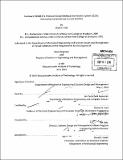| dc.contributor.advisor | Steven B. Leeb. | en_US |
| dc.contributor.author | Tidd, Chad N. (Chad Norman) | en_US |
| dc.contributor.other | Massachusetts Institute of Technology. Engineering Systems Division. | en_US |
| dc.date.accessioned | 2011-03-24T20:25:01Z | |
| dc.date.available | 2011-03-24T20:25:01Z | |
| dc.date.copyright | 2010 | en_US |
| dc.date.issued | 2010 | en_US |
| dc.identifier.uri | http://hdl.handle.net/1721.1/61908 | |
| dc.description | Thesis (Nav. E.)--Massachusetts Institute of Technology, Dept. of Mechanical Engineering; and, (S.M. in Engineering and Management)--Massachusetts Institute of Technology, Engineering Systems Division, 2010. | en_US |
| dc.description | Cataloged from PDF version of thesis. | en_US |
| dc.description | Includes bibliographical references (p. 91-92). | en_US |
| dc.description.abstract | A hardware model of a shipboard electrical distribution system based on aspects of the DDG 51 Flight IIA, Arleigh Burke class, 60Hz Alternating Current (AC) and the future direct current (DC), zonal electrical distribution system (ZEDS). These distribution boards were designed and built for the purpose of testing electrical system components at the Massachusetts Institute of Technology's Laboratory for Electromagnetic and Electronic Systems (LEES). The combination of existing electrical generators and the newly created electrical distribution boards will provide a hereto unattained level of access for testing and evaluating a number of research topics currently being worked on at LEES. The level of reality inherent in this system will enable the user to refine experimental hardware and software in a safe and controlled environment. The user will benefit from a quicker product development process. Additionally, the ability to easily produce verifiable records to demonstrate the effectiveness/applicability of their individual experiments will help to progress research at LEES along the product development path. Two 5 kW generators serve as electrical generation for the ZEDS benchtop emulator boards. The hardware models support experimentation with AC and DC ZEDS power loading and protection. The hardware models reflect the AC ZEDS architecture employed on the DDG-51 class destroyers. The emulator is a three phase electrical system with both port and starboard buses, a computer interface to control the generators and contactors or solid state relays through a graphic user interface (GUI). The system is capable of being configured and operated in a split plant, parallel or single generator plant configuration. | en_US |
| dc.description.statementofresponsibility | by Chad N. Tidd. | en_US |
| dc.format.extent | 138 p. | en_US |
| dc.language.iso | eng | en_US |
| dc.publisher | Massachusetts Institute of Technology | en_US |
| dc.rights | M.I.T. theses are protected by
copyright. They may be viewed from this source for any purpose, but
reproduction or distribution in any format is prohibited without written
permission. See provided URL for inquiries about permission. | en_US |
| dc.rights.uri | http://dspace.mit.edu/handle/1721.1/7582 | en_US |
| dc.subject | Mechanical Engineering. | en_US |
| dc.subject | Engineering Systems Division. | en_US |
| dc.title | Hardware model of a shipboard zonal electrical distribution system (ZEDS) : alternating current/direct current (AC/DC) | en_US |
| dc.title.alternative | Hardware model of a shipboard ZEDS : AC/DC | en_US |
| dc.type | Thesis | en_US |
| dc.description.degree | S.M.in Engineering and Management | en_US |
| dc.description.degree | Nav.E. | en_US |
| dc.contributor.department | Massachusetts Institute of Technology. Department of Mechanical Engineering | |
| dc.contributor.department | Massachusetts Institute of Technology. Engineering Systems Division | |
| dc.identifier.oclc | 706827988 | en_US |
